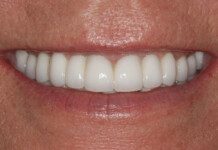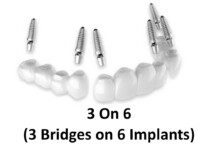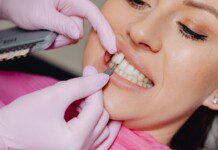
People who wear them know very well of the troubles with dentures and partials. They often suffer a number of different compromises. There are a few basic causes of these problems.
Common Causes of Denture Problems
First of all, dentures and partials are artificial substitutes that are nothing like the original teeth they’re replacing. Dentures are much larger than the teeth they replace. Because of the size difference, most patients who have them merely survive with dentures for lack of a better alternative.
Second, bite force is reduced by as much as 75%. When attempting to chew food, denture wearers must chew much longer than non-denture wearers. Typically, denture wearers substitute softer, fattier foods for their preferred foods, simply because they’re easier to eat. Teeth that shift around while they’re trying to chew make eating many of their favorite foods difficult.
Third, as the mouth remodels (loses bone) after tooth loss, the dentures begin to become loose and move around. Denture wearers compensate for this slippage by using adhesives and retraining their facial muscles to chew very carefully and deliberately, guarding their enthusiasm.
Solutions for Denture Woes
Dental implants have given denture wearers hope. As few as two dental implants can solve all of the above problems. When a patient chooses more than two implants, the possibilities for improvement are dramatically increased. Many patients choose to use more implants and do away with dentures altogether, opting instead for teeth that are fixed in place (non-removable).
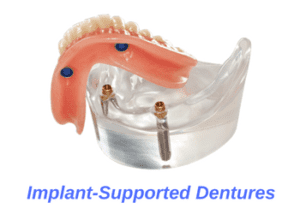 Just two implants will stabilize a (snap-on, removable) denture well enough to great improve chewing ability and comfort. This is the least expensive option for denture wearers and significantly increase the pleasure and comfort of eating.
Just two implants will stabilize a (snap-on, removable) denture well enough to great improve chewing ability and comfort. This is the least expensive option for denture wearers and significantly increase the pleasure and comfort of eating.
Common Causes of Partial Denture Problems
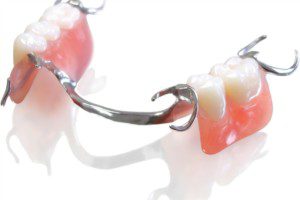 With partial dentures, these rely on an acrylic base that rest directly on the gums, and clasps that wrap around adjacent teeth for support. The problem most people face with partial dentures, is that they shift around while they are chewing food. This allows food to get trapped underneath the base of the partial and between the prosthesis and supporting teeth. Metal bases make then stronger, but they still sit directly on the gums and have clasps around a few select teeth to hold them in place. Many people with partial dentures find them quite uncomfortable to eat well with. For this reason, they typically just take them out when they’re eating alone when nobody can see them. They often find it more comfortable to eat, even with missing teeth, than with a prosthesis that shifts around while they’re chewing.
With partial dentures, these rely on an acrylic base that rest directly on the gums, and clasps that wrap around adjacent teeth for support. The problem most people face with partial dentures, is that they shift around while they are chewing food. This allows food to get trapped underneath the base of the partial and between the prosthesis and supporting teeth. Metal bases make then stronger, but they still sit directly on the gums and have clasps around a few select teeth to hold them in place. Many people with partial dentures find them quite uncomfortable to eat well with. For this reason, they typically just take them out when they’re eating alone when nobody can see them. They often find it more comfortable to eat, even with missing teeth, than with a prosthesis that shifts around while they’re chewing.
Solutions for Partial Denture Woes
 Dental Implants can be used to support partial dentures in the same manner as they do with overdentures. Instead of clasps wrapping around other teeth for support, the implants are placed in strategic places where teeth are missing and the partial snaps onto the implants and is supported by them. This makes chewing more predictable, stable and comfortable.
Dental Implants can be used to support partial dentures in the same manner as they do with overdentures. Instead of clasps wrapping around other teeth for support, the implants are placed in strategic places where teeth are missing and the partial snaps onto the implants and is supported by them. This makes chewing more predictable, stable and comfortable.
Dental specialists called Prosthodontists are the experts in dental implant and prosthetic treatments. A Prosthodontist is also the expert in crowns, bridges, dentures and partials.
If you’re unable to get implants and are limited to a partial or a denture, a Prosthodontist has the best chance of designing one that will serve you with the least amount of discomfort. But dental implants – are the best solution to these problems.
If you have dental needs and would like to learn more about ALL the options available for your specific needs, CONTACT US and schedule a COMPLIMENTARY CONSULTATION. All it costs is your time. The information is yours for the taking.

